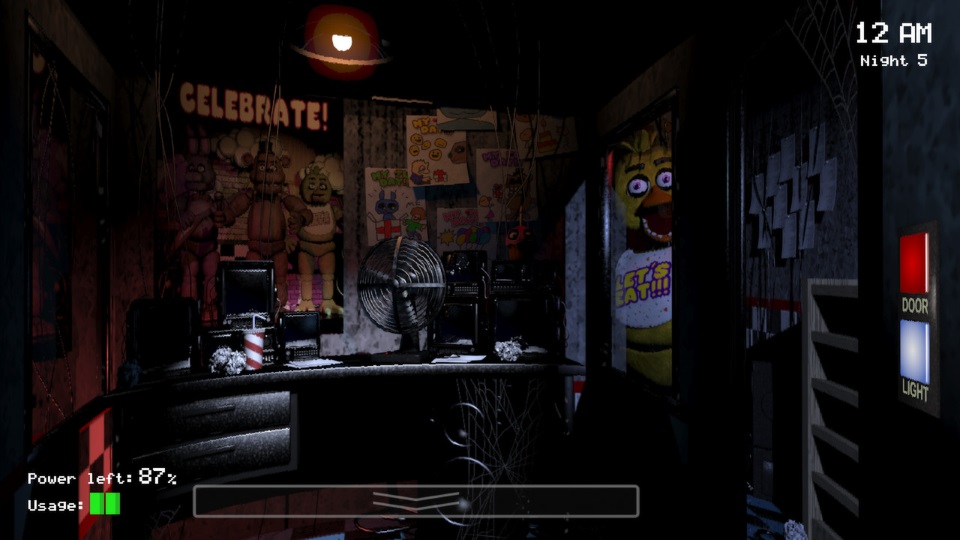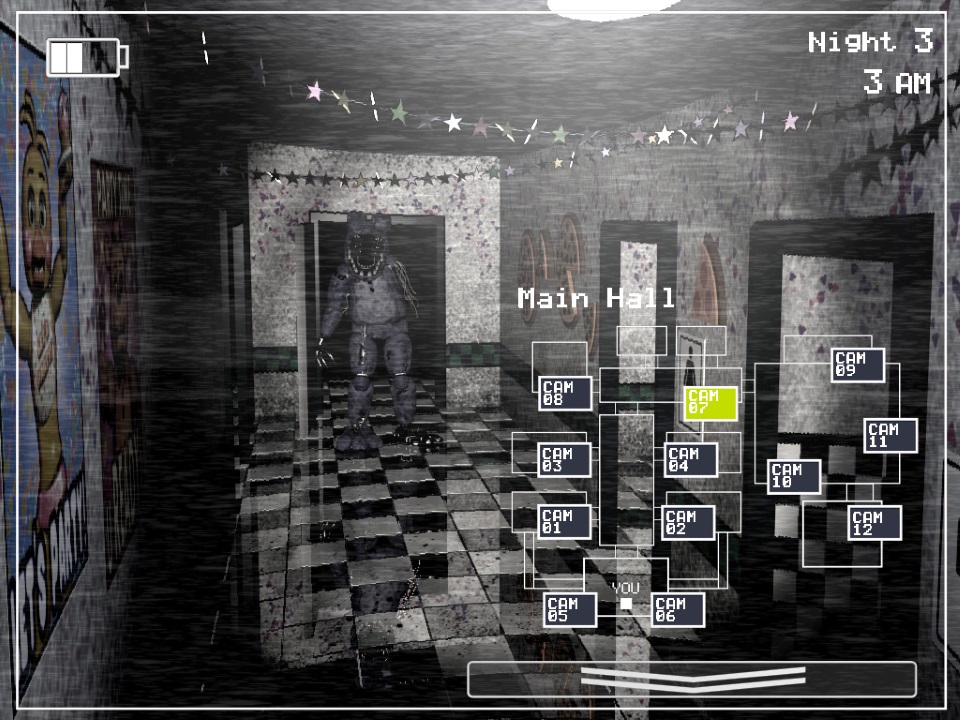But still, puzzles are usually only one small slice of the survival horror pie, as they are in any game. Generally, stealth and adventure elements are present in survival horror games too, stealth being the main way to avoid dying and adventure elements to help you figure out where to go next (and contrive reasons for you to backtrack so the monster can get extra swipes at you). Puzzles are secondary despite their prevalence, and largely not even the main draw.
But what if the situation was reversed? What if we weren’t playing a horror game that utilized puzzles, but rather we were playing a puzzle game that utilized horror?
If we were, there’s a pretty damn good chance we’re playing Five Nights at Freddy’s.

Despite being a low-budget indie game, it’s very unlikely you haven’t heard of this little gem. Despite it’s simple premise and simpler gameplay, it’s one of the top-tier horror games in the genre, right up there with the original Slender. In it, you play as a night security guard at a Chuck E. Cheese from hell, trying to do your best to avoid getting murdered by the possessed animatronics with only security cameras, and depending on if you’re playing the first or second game, either a set of doors or a flashlight and a bear mask.
When you put it that way, it sounds pretty silly…
The game is described on its Steam Page as a horror game, and that certainly fits: it’s one of the scariest games in gaming, easily surpassing, say, Alien: Isolation or The Evil Within. But I don’t think that’s what it is, at least, not at its core. Rather, Five Nights at Freddy’s is a rare example of a pure puzzle game that simply wears the skin of a horror title.
Think about what we discussed above. If you think about any other type of horror game that fits the standard definition of survival horror—Slender, PT, The Evil Within, Alien, The Path, Amnesia, Silent Hill, Resident Evil, Clock Tower, the plethora of other indie horror games surfacing on Steam—being spotted by the enemy doesn’t automatically kill you. Rather, you always have a chance to outwit or hide from the monsters; even if catching you immediately means death, you’ll always have that opportunity to use other gaming skills to escape.
That’s not the case at Five Nights at Freddy’s. You can’t run, you can’t exactly hide, per say, there’s no way to fight the animatronics off: the only tool you have to survive are the puzzle mechanics. Keeping track of the animatronics, prioritizing which ones need your attention, and quickly figuring out what needs to be done to stave off your inevitable death until 6 am… the punishment for failure may be a jump scare and death, but if you were to take away all the scary parts, this would be the kind of mental exercise you might find in Brain Age, or a Professor Layton game.
And I think that might be one of the reasons it’s so scary. Sure, I’m as weirded out by animatronics as anyone else, but I don’t think it’s the robots, or the atmosphere, or even the plot that makes people so scared. It’s the knowledge that the exercise is entirely mental—there’s no second chances, no hiding and hoping the AI is dumb, the brainpower the terror of the situation is compromising is necessary to live. It’s a loop of being stressed and panicking, thereby making it harder to keep up with the robots, which stresses you out even more, and thus the robot’s edge continues to grow.

That’s how Five Nights at Freddy’s stays fresh for so much longer than a lot of horror games. It’s a real problem in the genre, where after people die and reload a lot of the tension vanishes as they remember it’s just a game and they have as many retries as they need. Death is often relaxing in horror games, in that respect, but this cycle of pressure the game cultivates means that even if you calm down after dying, the pressure of solving the puzzle—which, again, is your only tool—softens up your mind and makes you vulnerable to the scares again.
That’s a master class in horror game design.
I suspect we’ll see a lot more games attempt to ape this particular design choice—probably by just forcing the player to stay stationary and use tools to avoid death. Hopefully, they learn what makes the game really work, instead of just emulate it’s style.

 by
by 


Comments
Comment on this Article in our ForumMore GamerzUnite News
Are We Being Controlled in a PC Game by Aliens?
New UFO Film proposes we might!
Explore an Eerie Archipelago in Dredge
A fishing adventure gone bad...
Metasport Arena and Burrst Open the NIL Door for College and High School Gamers
The future looks bright...
Automation Goes Too Far in The Last Worker
A bleak future for anyone looking for a job...
Alien Infestation takes over in From Space
Liberate the Earth in this fun new action-shooter...
The Ascent Cyber Heist DLC takes Cyberpunk Heists to a New Level
New Missions, Side Quests and more...